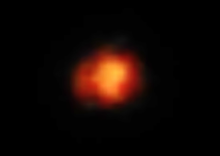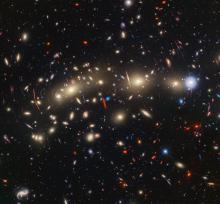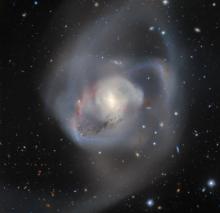Listen to today's episode of StarDate on the web the same day it airs in high-quality streaming audio without any extra ads or announcements. Choose a $8 one-month pass, or listen every day for a year for just $30.
You are here
Puffy Disk
Nine billion years ago, another galaxy rammed into the Milky Way. It was only a tiny fraction the mass of the Milky Way, but it might have had a major impact on our home galaxy.
Remnants of the galaxy were discovered within the last few years. It was given a couple of names: Gaia-Enceladus, and the Sausage, for the shape of its remains.
According to simulations, the galaxy was only about one-and-a-half percent the mass of the Milky Way. As it plunged through the Milky Way’s disk, though, its gravity stirred up the disk. That made the disk a lot “puffier” — it more than doubled in thickness.
At the same time, clouds of gas from the interloper rammed into similar clouds in the Milky Way. The clouds collapsed to give birth to new stars — many millions of them. Those stars congregated along the plane of the disk, while many of the older stars stayed away from that plane. That gave the Milky Way two disks — a thin one within a thicker one — a structure it maintains even today.
Finally, the gravity of the Milky Way ripped Gaia-Enceladus-Sausage apart. Many of the stars of the smaller galaxy formed long ribbons that loop around the center of the Milky Way. The stars belong to the Milky Way’s halo — a thinly populated region that extends hundreds of thousands of light-years in every direction. In fact, they make up a large fraction of the halo’s stars — stars that now belong to the Milky Way.
More about the Milky Way tomorrow.
Script by Damond Benningfield






